Introduction
In today’s fast-paced urban lifestyle, we often find ourselves spending the majority of our time indoors—whether at home, in the office, or other enclosed spaces. As a result, indoor air quality has become a growing concern. From pollutants like formaldehyde and benzene found in household products to dust, mold, and other allergens, our indoor environments can harbor a range of harmful toxins. While modern air purifiers offer one solution, there’s a natural, eco-friendly, and visually appealing alternative: air purifying plants.
According to NASA’s Clean Air Study, certain indoor plants have the remarkable ability to filter out common volatile organic compounds (VOCs) and improve overall air quality. These plants not only act as natural air filters but also enhance your living space with lush greenery, improve humidity levels, and contribute to a calming, stress-reducing environment. Best of all, many of these plants require minimal care and are ideal for beginners.
In this blog post, we’ll introduce you to the Top 10 Best Air Purifying Plants for Your Home, backed by science and loved by plant enthusiasts. Whether you’re looking to create a healthier home environment, reduce indoor pollutants naturally, or simply add a splash of green to your interiors, these plants are the perfect choice. Read on to discover which air purifying plants are the easiest to grow and most effective at keeping your indoor air clean and fresh.
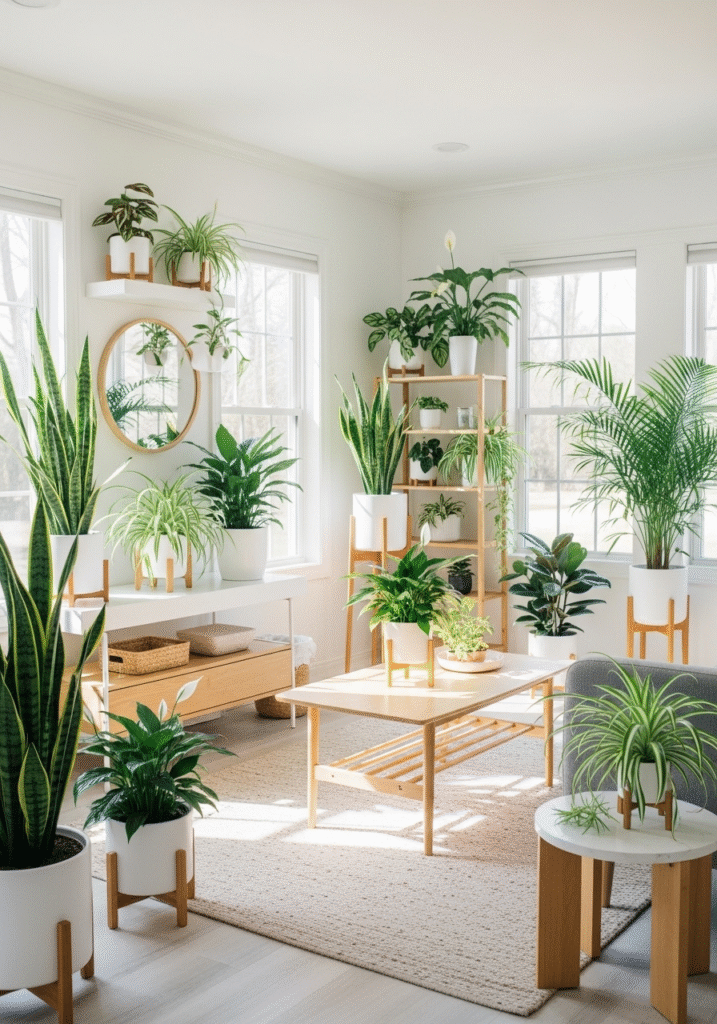
1. Spider Plant (Chlorophytum comosum)
The Spider Plant is one of the most popular and beginner-friendly indoor plants, loved for its striking arching green and white striped leaves and its exceptional air-purifying qualities. Known for being incredibly low-maintenance, this plant is an excellent choice for both seasoned plant parents and first-time indoor gardeners.
Why It’s Great:
Spider Plants are champions when it comes to removing indoor air pollutants. According to NASA’s Clean Air Study, they can effectively eliminate common toxins such as formaldehyde, carbon monoxide, xylene, and benzene—chemicals commonly found in furniture, cleaning products, and household items. Their ability to improve indoor air quality while requiring minimal care makes them a top choice for homes, offices, and classrooms.
One of the standout features of the Spider Plant is its ability to produce “pups” or baby plants, which dangle from the mother plant like little spiders—hence the name. These pups are easy to propagate, allowing you to grow new plants and share them with friends or expand your indoor garden effortlessly.
Care Tips:
- Light: Prefers bright, indirect sunlight but can also tolerate low light conditions, making it suitable for almost any room in the house.
- Water: Water moderately and allow the soil to dry out between waterings. Overwatering can lead to root rot, so it’s best to err on the side of underwatering.
- Humidity: Enjoys moderate humidity but is quite adaptable to various indoor climates.
- Temperature: Thrives in temperatures between 60–75°F (16–24°C).
Fun Fact:
The Spider Plant is considered non-toxic to cats and dogs, making it one of the best pet-friendly houseplants you can grow. Its air-cleaning ability combined with its safe nature makes it ideal for pet lovers who want to green up their homes without worry.
Whether displayed in a hanging basket, on a windowsill, or as part of a plant shelf arrangement, the Spider Plant is a versatile, attractive, and health-boosting addition to any indoor space.
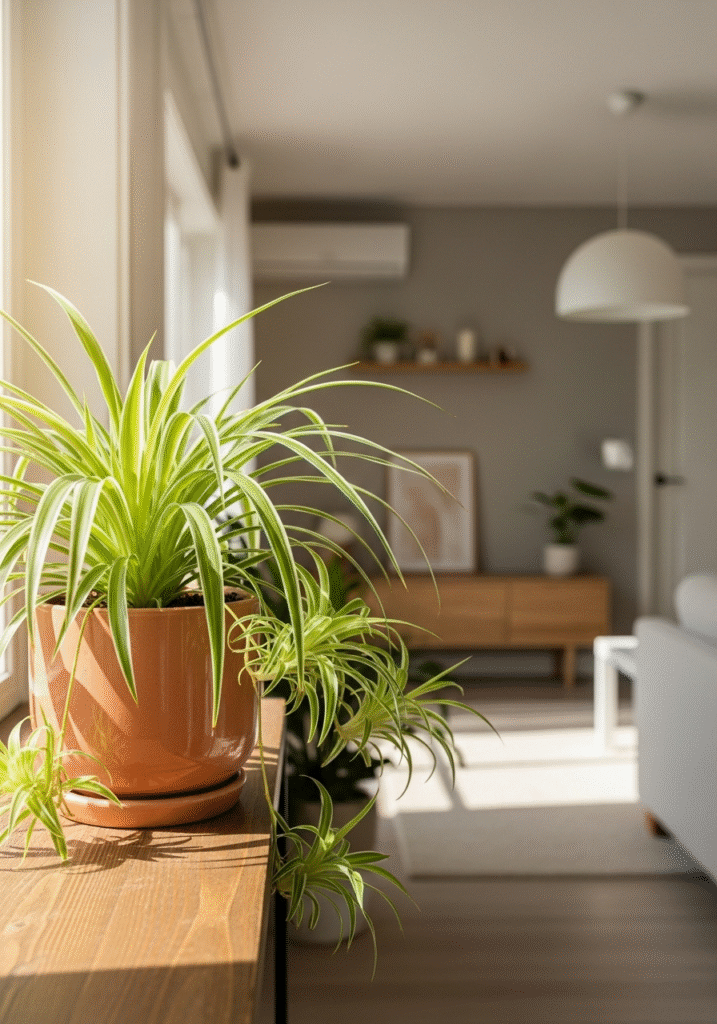
2. Snake Plant (Sansevieria trifasciata)
The Snake Plant, also known as Mother-in-law’s Tongue, is a striking and architectural indoor plant that’s as tough as it is beautiful. With its tall, upright sword-like leaves edged in yellow or silver-green, it adds a bold touch of greenery to any room. But it’s more than just decorative—this plant is a powerhouse when it comes to purifying indoor air.
Why It’s Great:
The Snake Plant is one of the top-rated air-purifying plants identified by NASA. It effectively filters out harmful toxins such as benzene, formaldehyde, trichloroethylene, toluene, and xylene, all of which are commonly found in paints, cleaning products, and synthetic materials. One of its most unique features is its ability to convert carbon dioxide (CO2) into oxygen at night, unlike most plants that only do so during the day. This makes it an ideal plant for bedrooms, as it continues to improve air quality even while you sleep.
In addition to its air-cleaning properties, the Snake Plant is extremely low-maintenance and resilient, often thriving on neglect. It’s a perfect choice for people with busy schedules, frequent travelers, or those who are new to plant care.
Care Tips:
- Light: Adaptable to a wide range of lighting conditions. It thrives in low light, but grows more vigorously in bright, indirect light.
- Water: Very drought-tolerant. Water only when the soil is completely dry. Overwatering is one of the few ways to harm this hardy plant.
- Humidity: Tolerates dry air well, making it perfect for modern indoor environments.
- Temperature: Prefers temperatures between 60–85°F (16–29°C) but can tolerate short drops in temperature.
Fun Fact:
The nickname “Mother-in-law’s Tongue” comes from its sharp, pointed leaves and unrelenting hardiness—traits often humorously associated with the stereotype. Despite the name, this plant is beloved for its beauty and strength.
The Snake Plant is also known to help reduce allergens and airborne pollutants, contributing to cleaner and fresher air. Its vertical growth habit makes it a great space-saving plant for small apartments, offices, or tight corners.
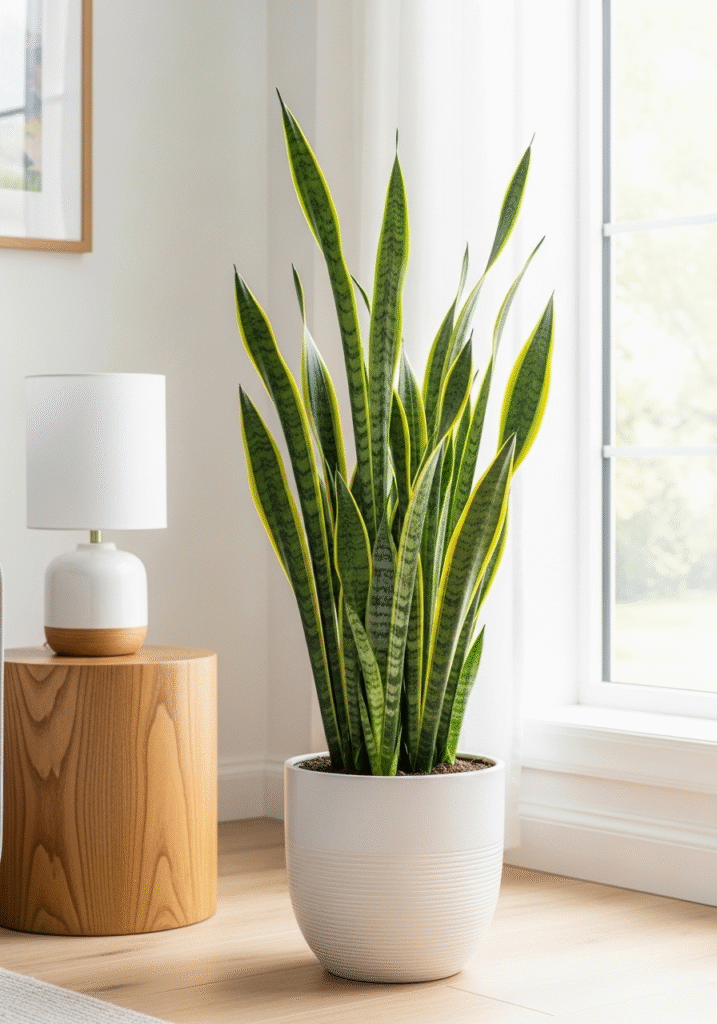
3. Peace Lily (Spathiphyllum)
The Peace Lily is a classic indoor plant known not only for its air-purifying properties but also for its elegant beauty. With its deep green leaves and striking white blooms, it brings a sense of peace and freshness to any space. Often associated with serenity and harmony, the Peace Lily is more than just a pretty face—it’s a natural air detoxifier that’s perfect for modern homes and offices.
Why It’s Great:
The Peace Lily is a standout in NASA’s Clean Air Study due to its ability to absorb a wide range of indoor air pollutants, including ammonia, formaldehyde, benzene, xylene, and trichloroethylene. These harmful chemicals are commonly found in household cleaners, paints, and adhesives. By filtering these toxins from the air, the Peace Lily helps create a healthier and more breathable indoor environment.
But beyond its functionality, the Peace Lily is also valued for its beautiful white spathes (often mistaken for flowers) that bloom several times a year under the right conditions. These blooms make it a great dual-purpose plant—offering both decorative appeal and health benefits.
Care Tips:
- Light: Prefers low to medium, indirect light. Too much direct sunlight can scorch its leaves, while very low light might reduce flowering.
- Water: Keep the soil consistently moist, but avoid letting it sit in water. The Peace Lily is sensitive to overwatering, so good drainage is essential.
- Humidity: Enjoys higher humidity levels, making it well-suited for bathrooms or kitchens.
- Temperature: Thrives in temperatures between 65–80°F (18–27°C) and dislikes cold drafts.
Fun Fact:
One of the easiest ways to know your Peace Lily needs water is that it dramatically droops when it’s thirsty—then perks right back up after a drink! This makes it an excellent beginner-friendly plant, especially for those still learning how to manage watering routines.
In addition to cleaning the air, the Peace Lily can help reduce mold spores in the home by absorbing them through its leaves and sending them to the root zone, where they are broken down. With its combination of beauty, simplicity, and functionality, it’s easy to see why the Peace Lily remains a top favorite among indoor plant lovers.
If you’re new to growing your own food, our easy guide on Vegetable Gardening for Beginners is the perfect place to start.
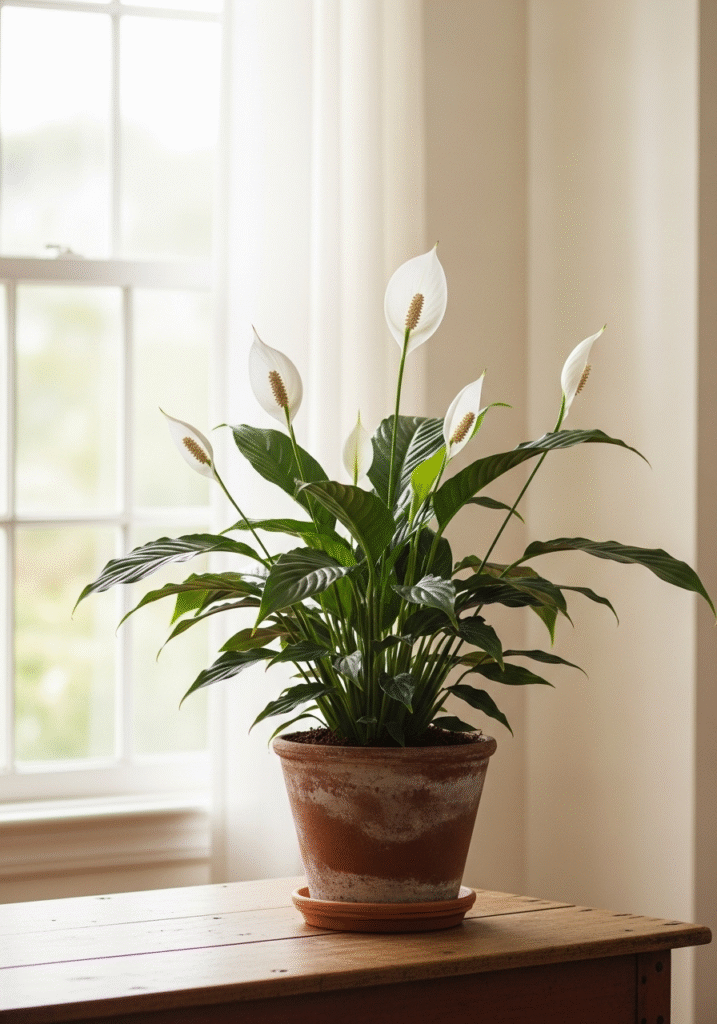
4. Aloe Vera
Aloe Vera is one of the most versatile and well-known indoor plants, celebrated for both its air-purifying abilities and its natural healing properties. With thick, fleshy green leaves that store moisture, this succulent is not only a stylish addition to any room but also a living first-aid kit. Aloe Vera is especially popular among health-conscious individuals and minimalist gardeners thanks to its dual benefits of cleaning the air and providing skin-soothing gel.
Why It’s Great:
Aloe Vera is recognized for its ability to filter out formaldehyde and benzene, two harmful chemicals frequently released from cleaning agents, paints, and synthetic materials. Placing an Aloe Vera plant in areas like the kitchen or bathroom can help reduce exposure to these toxins while adding a refreshing green accent to your décor.
In addition to its air-cleansing role, Aloe Vera is prized for the clear gel inside its leaves, which has anti-inflammatory, antibacterial, and healing properties. This gel is commonly used to soothe sunburns, minor cuts, dry skin, and insect bites, making it a natural and accessible remedy to have at home.
Care Tips:
- Light: Thrives in bright, indirect sunlight. A sunny windowsill or a well-lit corner is ideal. Avoid prolonged exposure to direct, intense sunlight, which may scorch the leaves.
- Water: Water deeply but infrequently. Allow the soil to dry out completely between waterings. Like most succulents, Aloe Vera is drought-tolerant and prefers dry conditions over wet.
- Humidity: Prefers low to moderate humidity and well-ventilated areas.
- Temperature: Best kept in temperatures between 55–80°F (13–27°C). Protect from frost or cold drafts.
Fun Fact:
The gel from Aloe Vera leaves has been used for thousands of years in skincare and traditional medicine. It’s still widely used in cosmetics, lotions, and even drinks. You can snap off a leaf and use the gel directly on your skin—an all-natural solution that’s right at your fingertips.
Aloe Vera is not only easy to grow but also a stylish and practical addition to your indoor plant collection. Whether you’re looking to detoxify your home or create a mini medicinal garden, Aloe Vera offers the perfect combination of beauty, function, and simplicity.
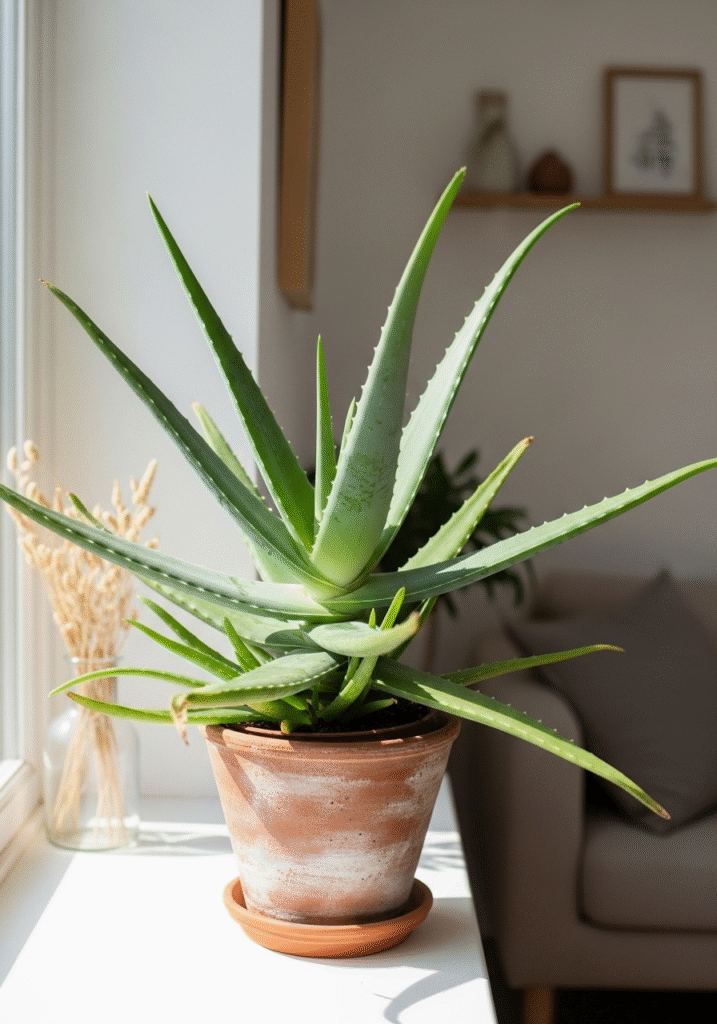
5. Areca Palm (Dypsis lutescens)
The Areca Palm, also known as the Butterfly Palm, is a stunning tropical plant that not only enhances your indoor decor with its lush, feathery fronds but also doubles as a natural humidifier. Native to Madagascar, the Areca Palm brings a touch of the tropics indoors, making it an ideal plant for bright spaces and those looking to improve their home’s air quality and humidity levels.
Why It’s Great:
The Areca Palm is one of the best plants for improving indoor air quality by filtering out harmful toxins like toluene and xylene—two chemicals commonly found in paints, varnishes, and adhesives. But its benefits don’t stop there. This plant also excels as a natural humidifier, as it releases moisture into the air through a process known as transpiration. This can help reduce dry skin, irritation in the eyes, and respiratory discomfort, especially during the winter months when indoor air tends to be drier.
Its ability to filter toxins while increasing humidity makes the Areca Palm a perfect addition to living rooms, offices, or even bedrooms, creating a more comfortable and healthier indoor environment.
Care Tips:
- Light: Prefers bright, filtered light, but can tolerate some indirect light. Avoid placing it in direct sunlight, as this can scorch its leaves.
- Water: Water when the top inch of the soil is dry. Be sure to drain excess water from the pot to prevent root rot. It’s better to underwater than overwater this plant, as it’s more tolerant of dry conditions than soggy soil.
- Humidity: Enjoys higher humidity but is fairly adaptable. Regular misting can help increase humidity, especially during the winter months.
- Temperature: Thrives in warm temperatures, ideally between 65–75°F (18–24°C). Keep it away from drafts and cold windows.
Fun Fact:
Under the right conditions, the Areca Palm can grow to a height of 6–7 feet indoors, making it a dramatic and beautiful feature plant. Its feathery fronds create a graceful, tropical feel that can instantly elevate any room.
The Areca Palm’s elegant appearance, combined with its ability to purify the air and naturally humidify your space, makes it an ideal choice for anyone looking to improve both the aesthetic and health quality of their indoor environment.
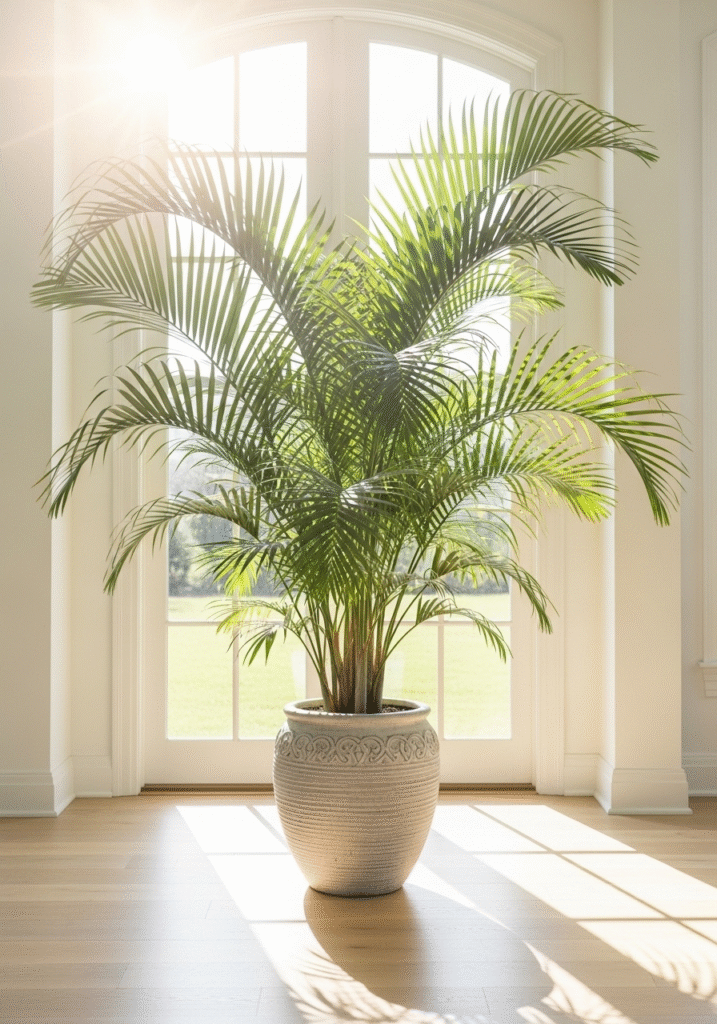
6. Boston Fern (Nephrolepis exaltata)
The Boston Fern is a timeless indoor plant beloved for its lush, feathery fronds and excellent air-purifying qualities. With its cascading green foliage, this fern adds a soft, natural touch to any room, while its impressive ability to filter out toxins makes it a top choice for those seeking both beauty and functionality in their indoor plants.
Why It’s Great:
Boston Ferns are incredibly effective at removing a variety of indoor pollutants, with a particular strength in filtering out formaldehyde, a harmful chemical found in furniture, textiles, and cleaning agents. By adding a Boston Fern to your space, you’re not only enhancing your home’s aesthetic but also improving its air quality by absorbing and neutralizing these toxins.
Another standout feature of the Boston Fern is its natural ability to increase indoor humidity. It does this by releasing moisture into the air through a process called transpiration, making it an ideal plant for dry indoor environments, particularly during the winter when indoor air can become quite dry. The added humidity helps reduce respiratory issues, dry skin, and eye irritation, making the Boston Fern a beneficial addition to bedrooms, living rooms, or even offices.
Care Tips:
- Light: Prefers indirect light and will thrive in areas with filtered sunlight. Avoid placing it in direct sun, as the strong rays can scorch the delicate fronds.
- Water: Keep the soil consistently moist, but not waterlogged. Boston Ferns love humidity, so regular watering is important, but be sure to empty any standing water from the saucer to prevent root rot.
- Humidity: This plant loves high humidity, making it perfect for bathrooms, kitchens, or areas with higher moisture levels. If you live in a dry climate, misting the leaves regularly will help.
- Temperature: Boston Ferns prefer temperatures between 60–75°F (15–24°C), but they should be protected from cold drafts and sudden temperature fluctuations.
Fun Fact:
Not only does the Boston Fern purify the air and boost humidity, but it’s also an excellent natural humidifier for the home. In addition, it’s one of the most effective plants for improving overall indoor air quality, earning it a spot on NASA’s list of top air-purifying plants.
With its graceful, trailing fronds, the Boston Fern is a standout plant that will thrive in any indoor space, especially those in need of a touch of greenery and improved air quality.
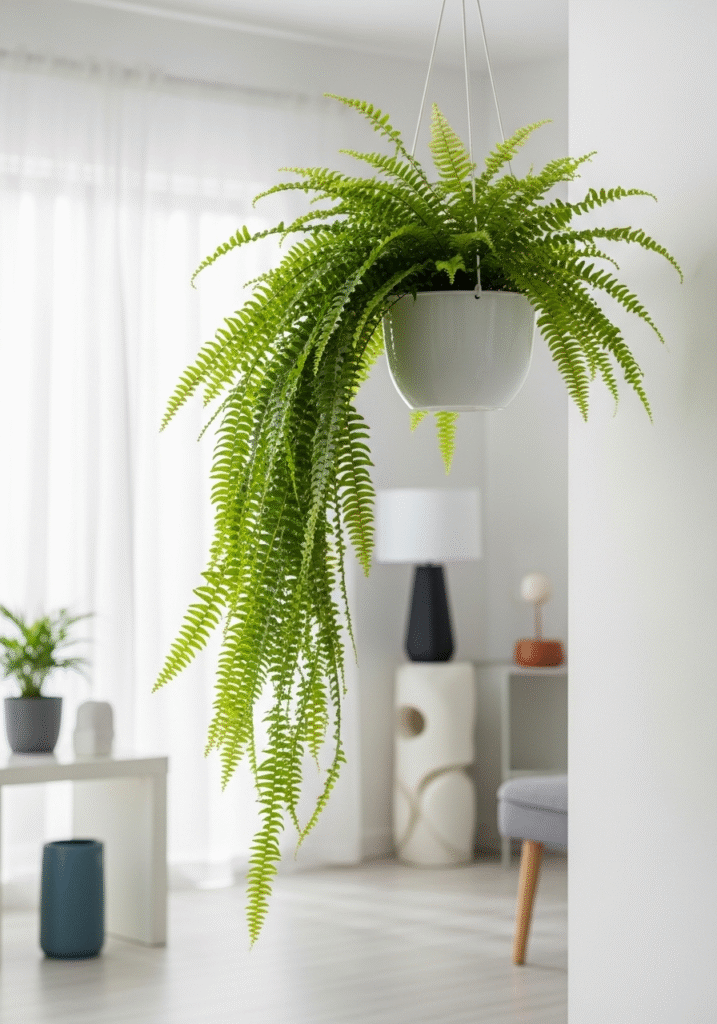
7. Rubber Plant (Ficus elastica)
The Rubber Plant, also known as Ficus elastica, is a striking indoor plant with large, glossy, dark green leaves that make a bold statement in any room. Known for its toughness and rapid growth, the Rubber Plant is not only a stylish addition to your home décor but also an effective air purifier that helps to detoxify your indoor environment.
Why It’s Great:
Rubber Plants are particularly effective at removing airborne toxins like formaldehyde, benzene, and trichloroethylene—chemicals commonly found in building materials, furniture, and household cleaners. Its large, waxy leaves absorb these pollutants, helping to purify the air and improve overall indoor air quality. This makes the Rubber Plant an excellent choice for homes or offices where air purification is a priority.
In addition to its air-purifying abilities, the Rubber Plant’s bold, glossy green leaves make it a standout piece in any room, providing a touch of natural beauty and sophistication. It can grow quite tall, often reaching up to 8 feet indoors, making it an ideal statement plant for large spaces or rooms in need of a focal point.
Care Tips:
- Light: Prefers bright, indirect light, although it can tolerate moderate light. However, low light conditions may cause the plant to grow more slowly and reduce the vibrancy of its leaves.
- Water: Water when the top layer of soil has dried out. Rubber Plants are susceptible to root rot, so it’s important not to overwater. Ensure the pot has good drainage to allow excess water to escape.
- Humidity: While Rubber Plants can adapt to typical indoor humidity, they thrive in moderate to high humidity. Occasional misting or placing the plant near a humidifier can help it thrive in drier climates.
- Temperature: Ideal temperatures range between 60–75°F (16–24°C). It prefers warmth and should be protected from cold drafts or sudden temperature changes.
Fun Fact:
Known for its resilience, the Rubber Plant can tolerate a variety of conditions and is well-known for its fast growth. Under optimal care, it can grow several feet per year, making it a great choice for those looking to quickly fill up a space with greenery. It’s also relatively low-maintenance, making it perfect for beginners or those new to indoor plants.
Whether you’re looking to add a dramatic touch of greenery to your home or purify the air in your office, the Rubber Plant’s striking appearance and powerful air-cleansing capabilities make it a standout choice for any space.
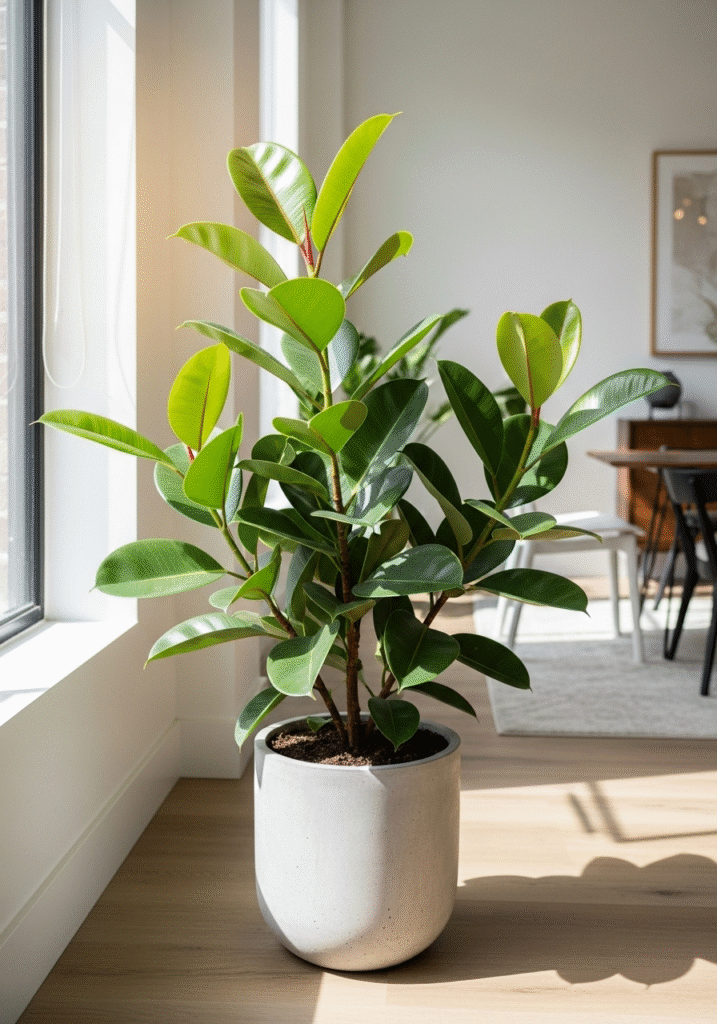
8. Chinese Evergreen (Aglaonema)
The Chinese Evergreen (Aglaonema) is an excellent choice for both beginner and seasoned plant enthusiasts, offering a combination of beauty, air-purifying benefits, and ease of care. With its stunning variegated leaves in shades of green, silver, and red, this plant is an eye-catching addition to any indoor space, whether placed on a desk, shelf, or as a floor plant. It’s not just a decorative element—it also plays a role in improving indoor air quality.
Why It’s Great:
The Chinese Evergreen is particularly effective at removing common indoor pollutants like formaldehyde, benzene, and xylene, which are often present in cleaning supplies, furniture, and other household materials. By filtering these toxins from the air, the Chinese Evergreen helps to create a cleaner, healthier living environment.
One of its standout features is its attractive, variegated foliage, which can come in a wide variety of patterns and colors, including deep green, silver, and even hues of red and pink. Its bold, colorful leaves make it a versatile plant that complements a variety of interior styles, from modern minimalist to traditional home decor.
Care Tips:
- Light: The Chinese Evergreen thrives in low to medium light conditions, making it perfect for spots with indirect light or areas of the home that don’t receive a lot of direct sun. It can tolerate some shade, but too much sunlight can cause the leaves to burn or fade in color.
- Water: Water moderately, ensuring that the top layer of the soil dries out before watering again. It’s important not to overwater, as this can lead to root rot. Ensure the pot has good drainage to avoid water buildup.
- Humidity: The Chinese Evergreen is quite adaptable to different humidity levels but thrives in moderate to high humidity. Misting the plant occasionally or placing it in a bathroom can help maintain healthy growth.
- Temperature: It prefers temperatures between 60–75°F (16–24°C) and should be protected from drafts or sudden temperature fluctuations.
Fun Fact:
The Chinese Evergreen is available in many color variations, including shades of red, silver, and pink, making it one of the most diverse and colorful houseplants. This variety allows plant lovers to choose a cultivar that perfectly complements their interior design and personal style.
Known for being low-maintenance, the Chinese Evergreen is ideal for anyone who wants to enjoy the benefits of houseplants without worrying about complex care routines. Its ability to thrive in low light and its air-purifying properties make it a great choice for apartments, offices, or any indoor space where air quality is a concern.
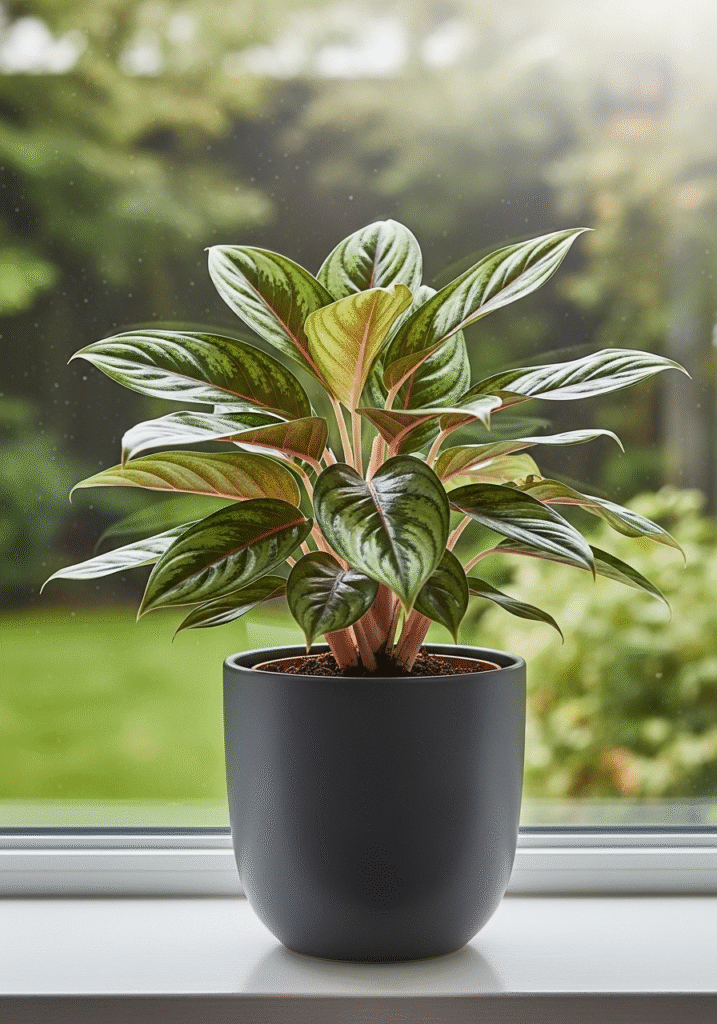
9. Dracaena (Dracaena spp.)
The Dracaena is a diverse and versatile genus that offers over 120 species, each with its own unique leaf patterns, colors, and growth habits. Whether you’re looking for a plant with striking variegated foliage, vibrant red-edged leaves, or a sleek and minimalist aesthetic, there’s a Dracaena variety to suit almost every interior style. But it’s not just about good looks—Dracaena is also highly effective at improving indoor air quality.
Why It’s Great:
Dracaena plants are highly efficient at eliminating a wide range of harmful chemicals, including trichloroethylene, xylene, and benzene—toxins commonly found in paints, furniture, and household cleaners. By removing these pollutants from the air, Dracaena helps to maintain a healthier and more breathable indoor environment, making it an excellent plant for homes and offices.
What sets Dracaena apart from other air-purifying plants is its impressive variety. Whether you choose the Dracaena marginata (with its spiky red-edged leaves), Dracaena fragrans (with broad, green or yellow-striped leaves), or Dracaena reflexa (with twisted, fragrant foliage), each species offers its own distinct aesthetic. Its ability to thrive in different conditions and its architectural form make it a popular choice for interior spaces in need of a touch of greenery.
Care Tips:
- Light: Dracaenas thrive in indirect sunlight. They prefer bright, filtered light but can also tolerate lower light levels, though this may result in slower growth. Avoid placing them in direct sunlight, as this can cause their leaves to scorch.
- Water: Water when the topsoil has dried out, being careful not to overwater. Dracaenas are sensitive to excess moisture, which can lead to root rot. It’s best to let the soil dry out slightly between waterings, especially in cooler months.
- Humidity: Dracaena plants are quite adaptable, though they prefer moderate to high humidity. Regular misting or placing the plant near a humidifier can encourage healthy growth, especially in dry climates.
- Temperature: Ideal temperatures for Dracaena range from 65–75°F (18–24°C). They should be kept away from cold drafts and sudden temperature changes.
Fun Fact:
With over 120 species of Dracaena, it’s one of the most diverse plant genera in the world. Some Dracaenas have broad, arching leaves, while others have more slender, upright foliage. This variety of species allows for numerous aesthetic options to match any decor.
Dracaenas are not only visually striking but also incredibly easy to care for, making them an ideal choice for both novice and experienced plant owners. Their air-purifying properties, coupled with their attractive foliage, make them a standout addition to any room, from homes to offices.
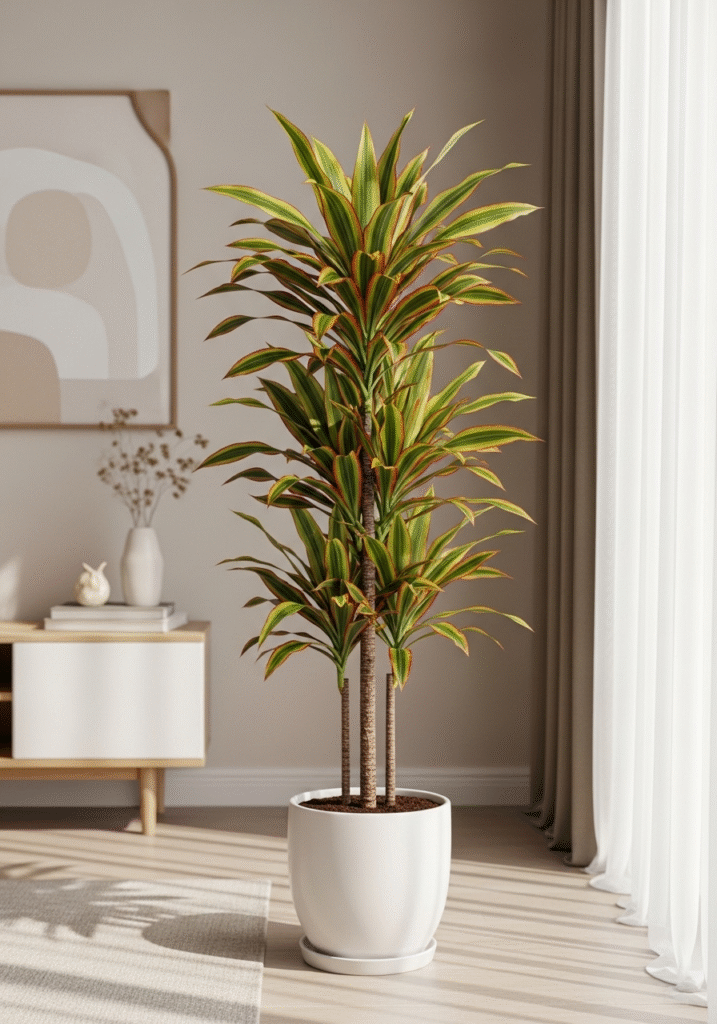
10. English Ivy (Hedera helix)
English Ivy (Hedera helix) is a versatile and highly effective air-purifying plant that can enhance both the beauty and health of your indoor space. Known for its classic ivy vines and ability to thrive in various conditions, it’s a plant that adds a touch of greenery to any room while also helping to improve air quality. Whether it’s cascading from a hanging basket or climbing along a trellis, English Ivy is a stylish and functional addition to your plant collection.
Why It’s Great:
One of the key benefits of English Ivy is its remarkable ability to reduce airborne mold and mildew, making it a particularly valuable plant for homes with high humidity or those that experience mold problems. Studies have shown that English Ivy can help absorb and remove harmful airborne spores and toxins, improving overall air quality and reducing respiratory irritants.
In addition to its air-purifying capabilities, English Ivy is an incredibly adaptable plant, capable of thriving in a variety of light conditions and environments. Its trailing vines can be trained to climb walls, trellises, or other indoor structures, creating a unique, vertical garden effect. The plant’s rich green leaves make it a beautiful and versatile option for both modern and traditional interiors.
Care Tips:
- Light: Prefers moderate to bright light, though it can tolerate some shade. While English Ivy can adapt to lower light, it may grow more slowly and have less vibrant foliage in dimmer spaces.
- Water: Keep the soil evenly moist, but avoid letting it sit in water. Ensure the pot has good drainage, as English Ivy can be susceptible to root rot if overwatered.
- Humidity: Thrives in moderate to high humidity, but it is adaptable to typical indoor humidity levels. If you live in a dry area, misting the leaves or placing the plant near a humidifier can help it flourish.
- Temperature: Prefers temperatures between 50–70°F (10–21°C), making it ideal for most indoor environments. Protect it from cold drafts, as it can be sensitive to extreme temperature changes.
Fun Fact:
English Ivy is known for its climbing ability—it can easily be trained to cover walls, trellises, or even furniture, creating a living green wall indoors. It’s perfect for adding vertical interest and creating a more natural, lush atmosphere in any room.
With its easy care requirements and air-purifying properties, English Ivy is a great choice for those looking to enhance their indoor space both visually and functionally. Its ability to help reduce mold, improve air quality, and grow in various conditions makes it a highly versatile plant that fits perfectly into any home or office settin
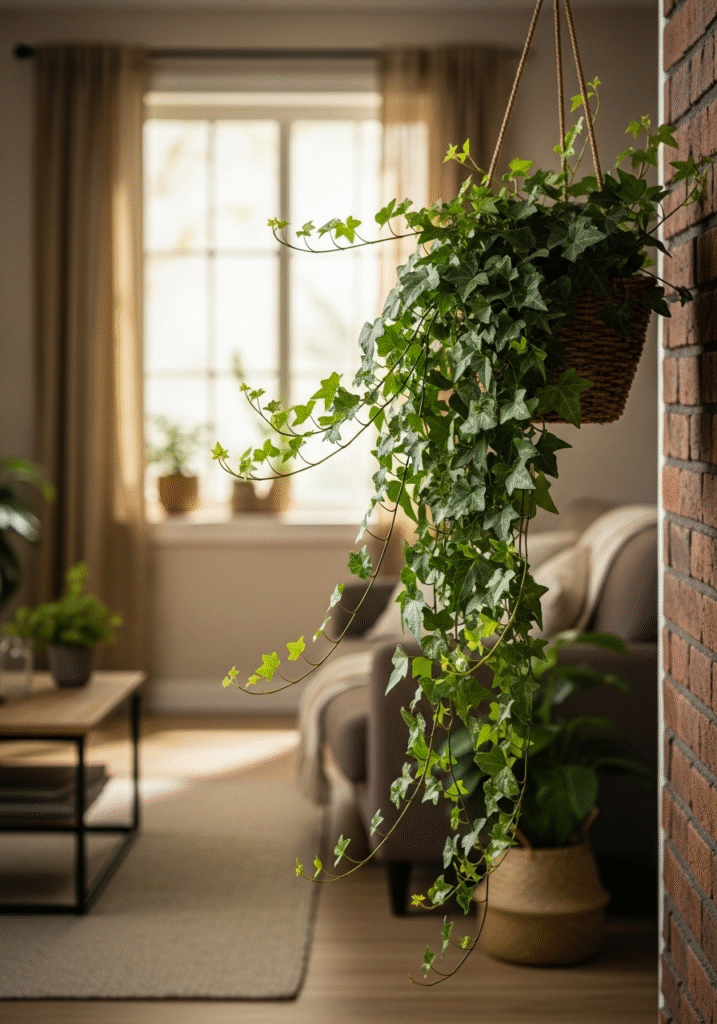
Conclusion
Incorporating air-purifying plants into your home is one of the easiest and most natural ways to improve indoor air quality and create a healthier environment. Beyond their ability to filter harmful toxins and pollutants, these plants offer a wide range of additional benefits—ranging from reducing stress and improving mood to boosting productivity and enhancing the aesthetics of your space.
Whether you choose the hardy Snake Plant, the elegant Peace Lily, or the versatile Spider Plant, adding any of the Top 10 Air-Purifying Plants to your home will not only improve the air you breathe but will also bring a touch of nature indoors. The presence of greenery has been shown to have positive effects on mental and physical well-being, making it the perfect addition to any room, whether it’s your living area, office, or bedroom.
In today’s world, where we spend most of our time indoors, it’s more important than ever to prioritize clean air and a healthier indoor environment. These plants are not only effective in purifying the air but also offer an eco-friendly solution to improve the overall atmosphere of your home.
So, go green, stay clean, and embrace the many benefits of indoor plants. Transform your living space into a fresher, more vibrant, and healthier environment—one plant at a time.


Pingback: Vegetable Gardening for Beginners: A Complete Guide to Growing Your Own Fresh Vegetables - pademoluxury.com